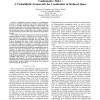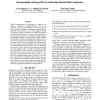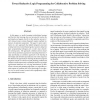66 search results - page 7 / 14 » Bridging the Gap between Task Planning and Path Planning |
CRV
2011
IEEE
12 years 7 months ago
2011
IEEE
— Algorithmic problem reduction is a fundamental approach to problem solving in many fields, including robotics. To solve a problem using this scheme, we must reduce the problem...
RSS
2007
13 years 9 months ago
2007
— Three-dimensional digital terrain models are of fundamental importance in many areas such as the geo-sciences and outdoor robotics. Accurate modeling requires the ability to de...
AIPS
2010
13 years 8 months ago
2010
Efficient management and propagation of temporal constraints is important for temporal planning as well as for scheduling. During plan development, new events and temporal constra...
IAT
2006
IEEE
14 years 1 months ago
2006
IEEE
In this paper, we tackle learning in distributed systems and the fact that learning does not necessarily involve the participation of agents directly in the inductive process itse...
IJRR
2002
13 years 7 months ago
2002
Exact cellular decompositions represent a robot's free space by dividing it into regions with simple structure such that the sum of the regions fills the free space. These de...



